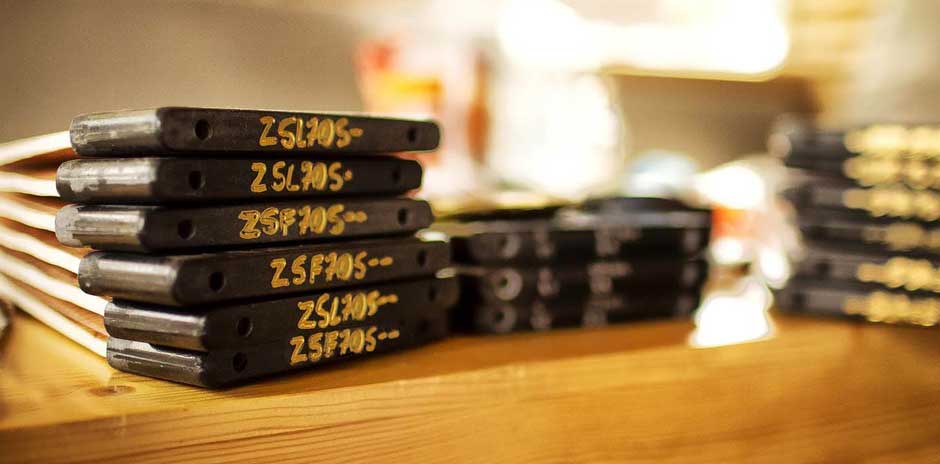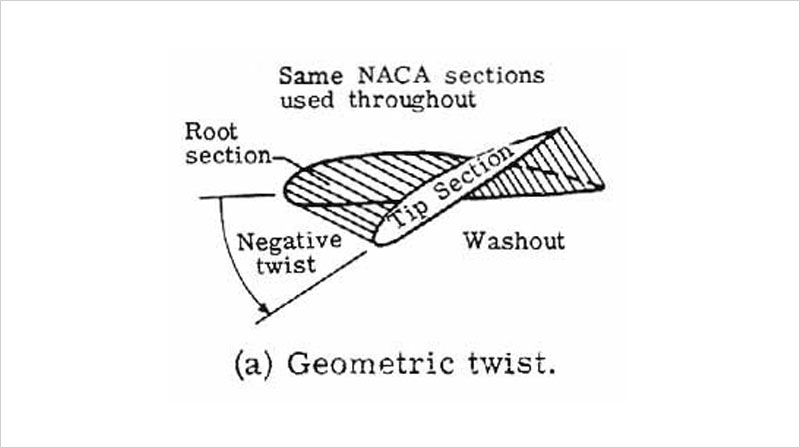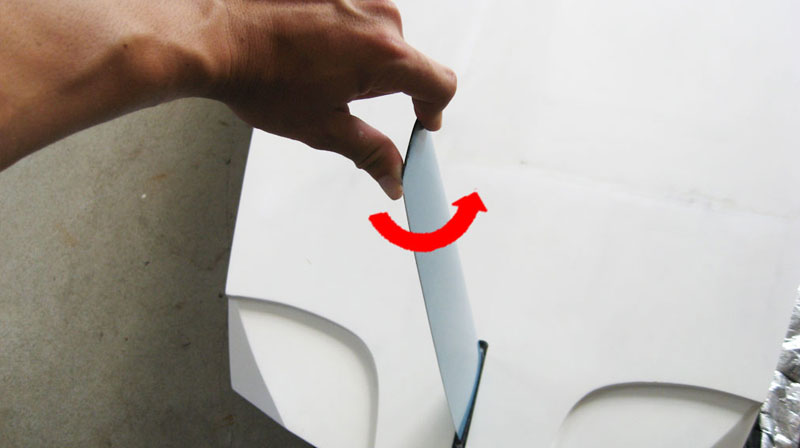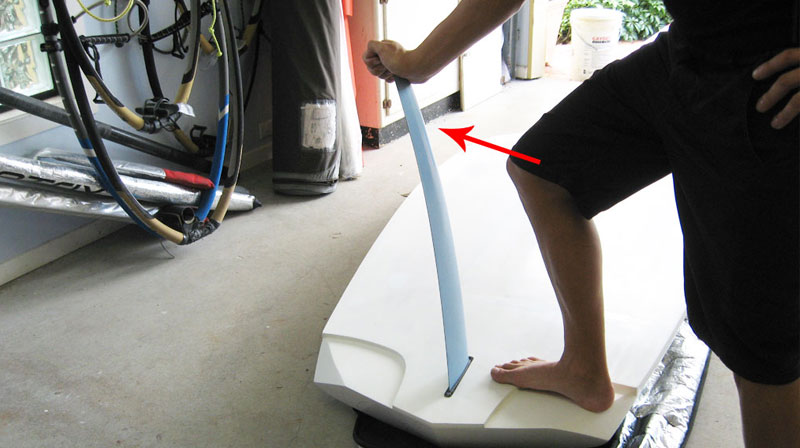
One of the single most important aspects to your FW setup is what is under your feet; fins. As a result, fins have been somewhat an aspect that people obsess about a little too much. As it stands right now, there are 4 mainstream fin makers in the World who’s fins are actively being used on the FW Pro Circuit (apologies to the smaller, lesser known fin companies who I have left out): Deboichet, Kashy, Select, Hurricane, whereby nearly 70% of those are Deboichet made. Each fin company makes a variety of foils in a number of flex stiffnesses, torsional stiffnesses, rakes and twist, which doesn’t make buying a new fin an easily made decision. Coupled with long queues on fin orders and high price tags, many people end up spending money on fins that aren’t helping them. Understanding some basic theory and terminology used in the fin-world might just help you make an informed decision before you part with your hard earned money. Understanding what the fin does to the trim of your board and what you should be looking for when you test fins against each other, might even be more useful. Here we will attempt to do both …
First and foremost, it is important to clarify a few aspects of terminology used when people talk about fins, as scouring the popular windsurfing forums over the past few years you will find a plethora of information where people are using terms incorrectly and are only adding to the confusion. Here are a few of the key terms used in fin-ology.

Rake:
Rake is simply the angle of the leading edge of the fin, relative to a line perpendicular to the bottom of the board. Everyone started thinking about modifying the rake of their fins in a more mainstream sense around the 2003 FW Worlds. As Deboichet represented about 95% of the fin market at that time, the ‘rake’ scale became popularised under a number system only applicable to Deboichet fins.
Deboichet uses a scale such as +4cm, +6cm, +8cm etc (where +11cm is vertical). Both Kashy and Hurricane use a scale such as 2 degrees, 3 degrees etc (where 0 degrees is vertical).
Deboichet: +8cm = 2.5 degrees = 30mm back from vertical.
Ps. Remember that MORE rake, means the fin is LESS upright (more swept-back at the tip). Because Deboichet’s scale is counting up as you decrease the rake, a lot of people have mistakenly written on forums about more rake when they are actually talking about moving fins from +6cm to +8cm, which is LESS rake.
Generally speaking, the more upright your fin is, the more lift it generates at the expense of induced drag. In light winds, people usually have relatively upright fins and in strong winds, some may have their fins with a little more rake to keep control of the board. Another important point to understand about rake is that by changing the rake of a fin, you are also influencing the twist.

Twist:
Twist is probably one of the least well understood characteristics of a fin. It is most commonly mistaken as being ‘torsional-stiffness’, when it is in fact, something completely different. When sailing, the righting moment of the sailor is countered by the side-force (or lateral resistance) of the board and the lift provided by the fin. Twist (or in aerodynamic terminology, “geometric twist”) is the result of the lift developed by the fin acting very close to 1/4 of the chord, back from the leading edge, while the neutral axis for bending is about 40% back from the leading edge; so there is a torsional moment when the fin bends. Simply put, as you flex a fin when you sail, this causes the fin to twist.
The geometric twist is more pronounced if you have a fin that is more swept-back (raked). So you will probably get more twist with an R13 at +4cm than you would with an identical R13 at +8cm.
Twist is important for the performance of a fin both upwind and downwind. Having no twist in a fin allows you to generate a better upwind angle but at the expense of becoming uncomfortable (or difficult) to sail downwind. This is probably because twist reduces the induced drag of a fin (or vortex drag from the tip) which is a significant portion of the total drag of a fin at the speeds a windsurfer travels. The induced drag is reduced when the angle of attack [aoa] at the tip of the fin is less than the aoa at the root of the fin (particularly for a fin with a planform of a tapered leading edge, such as an R13).
*I’ve tried to keep this article relatively simple, but if you’d like to read some more about induced drag and geometric twist, try these:
Many top sailors will talk about the performance of their fins downwind, as much as they talk about it upwind. To be fast around the course you generally want a fin that performs downwind just as well as it did upwind. If you talk to some of the Pro’s on the circuit about downwind performance in fins you might hear them say that their fin is ‘working’ for them off the wind and allowing them to ‘drive’ off the fin to go extra deep. Most likely they are referring to the twist in their fin, as the twist allows the fin to ‘depower’ to some extent and let you drive off it, deeper downwind, whereas some fins with no twist are creating too much lift downwind and force you to head upwind, giving you that ‘uncomfortable’ feeling downwind.
Similarly, it’s been said by some Pro’s that soft fins that twist are actually faster upwind in high-winds (despite what’s in your mind about stiffer fins being better in high winds). The twist in the fin can help it depower when you’ve generated too much lift in a gust and help to settle the board down. Having a board with a very wide tail (+81cm) will help with the control in high winds also.

Torsional-Stiffness:
Put a fin in your board and then grip the tip of the fin with your thumb and index finger. Twist the fin tip like you are unscrewing the lid of a Coke bottle. What you are witnessing is ‘torsional stiffness’ and although it is related, it is NOT ‘twist’ in the sense of how a fin manufacturer will be measuring it.
High torsional stiffness has been recently receiving more focus with the popularity of the Kashy fins on the market. Most of the better Kashy fins I have seen are more torsionally stiff than the majority of Deboichet/Hurricane fins and I believe this helps the Kashy fins retain a constant angle of attack which helps increase lift whilst maintaining good upwind speed.
The confusing thing about twist vs torsional-stiffness is probably because some people may assume that a softer fin is always going to have less torsional-stiffness and therefore more twist, but in actual fact that is not true. Both twist and torsional-stiffness are dependent on the planform, rake and most importantly, the fibre directions when the fin is layed-up during manufacture. As a result, a fin with extremely high torsional-stiffness can be built to twist a lot, or it can be built to have no twist at all. It is not possible to check twist with your fingers using the method above; it is possible however, to gauge torsional-stiffness with your fingers using this method.

Flex-Stiffness:
This is the stiffness you generally hear referred to when you buy a fin. A soft fin, a S–, an XXS, a 651; or so the lingo goes. Choosing the right stiffness of fin for the conditions you are sailing is very important, however the choices are about as individual as they come and depends heavily on your technique, sail brand, board brand and wind/wave conditions.
In flat water (eg. a lake), you put a more constant load on your fin when sailing upwind whereas on the ocean with swell and wind blown chop on the swell, the load on the fin is spiking as you go over waves or if you get slightly airborne over a chop. The other thing to consider is rider weight and sail size. A 90kg rider holding his 11m in 25 knots is most likely putting a considerable amount more load on his fin than a 72kg rider on his 9.8m in the same wind.
Selecting A New Fin
So you are going to go and buy yourself a nice new shiny fin. First, you should ask yourself a few questions about what you want the fin for.
- Light winds? You most likely want a soft, powerful fin.
- Light winds in shifty/flukey conditions (ie, if you sail on an inland lake, with fresh water or in off-shore winds)? You most likely want a fin that points super high, even if it is slow; pointing high allows you to get into the new wind quicker.
- Medium-strong winds on the ocean? It’s possible you might want a fin that travels faster, even at the expense of a little height, to be able to dodge between swells and help with your downwind speed.
Now What? Some Ideas on Fin Tuning
Now that we’ve covered a little bit of terminology and some super basic ideas to think about when selecting a fin to buy, it’s time to move over to how to tune a fin and what to think about when you are testing fins against other fins. It is quite difficult to explain what you are looking for when you tune any aspect of your gear, let alone fins. Tuning fins is about an intuitive feeling for going fast, pointing high or going deep downwind and this key skill that the Pro’s possess is something that mere mortals find difficult to grasp. Notwithstanding what I have just said, I still believe it is important that someone at least makes an attempt to explain what this feeling is, because that knowledge is one of the most sought after pieces of information in competitive windsurfing and probably something that most Pro’s will not want to give away.
On that note… here goes…
The approach I suggest you use when testing fins involves 3 stages:
- Trying the new fin; understanding and learning its ‘effect’ on the board
- Testing the fin against the best fin you already have
- Testing against a training partner
Stage 1: The “Effect”
The first thing you should think about when you try a new fin is its “effect” on the board; paying most of your attention to the ‘trim’ of the board. Most boards, generally speaking, like to be sailed with the nose riding high (lifting a little) and railing well upwind with even pressure between the front and back legs (or a little more pressure on your back leg if necessary). Some fins do this naturally (like a standard R13), but with other fins (even some that may be faster than an R13) you may need to work hard to develop this response from the fin.
There is no substitute for time-on-water. Just go sailing and get used to the feeling off your new fin. Forget about changing settings at this stage. Just sail your new fin.
Stage 2: Test the Best
To test any fin, you should always test it against the best fin you already have. Go for a run on your current best fin and find the setup that gets the most out of that fin in the conditions you are currently sailing (boom height, mast-track position etc). Now without changing any gear settings, go for a run on the new fin and pay close attention to how this fin effects the trim of the board (does the board feel stickier? sluggish? more responsive? lifting the nose too much and losing control?). If there is a difference, the first thing to try is moving your mast-track. I always suggest moving your mast-track in larger movements; 3cm at a time can sometimes be good to get a first impression on trim. When you are more dialled in to the feeling you can start moving it 1cm at a time.
If there is no difference in how the board sails/rails upwind then try moving your mast-track around anyhow. It’s possible, this new fin, even though it hasn’t changed the trim of your board, could have more control at the top end and allow you to run the mast-track further back than your best fin, which may be a faster setting on your fw board.
Downwind, mostly you want to find a fin that helps fly-the-fin, which is, excessively railing to reduce the wetted surface-area of the board. Traditional tapered leading-edge fins with a little twist such as an R13 or Hurricane 4a will rail the board almost with no concentration necessary. Some of the newer, softer fins with more torsional-stiffness, (such as a new Select R07 or some model Kashy’s) might require a slightly more upright stance or different mast-track position to fly-the-fin more efficiently. The fins that will do this the best will depend on the board/sail combination being used.
Stage 3: Race Your Buddy
Now that you’ve tuned your gear to compliment your new fin, go and test it against your training partner to check its performance. It’s important in this stage to have a consistent training partner of a similar speed and one who appreciates the rules of ‘2-boat tuning’ and doesn’t just put you in the
